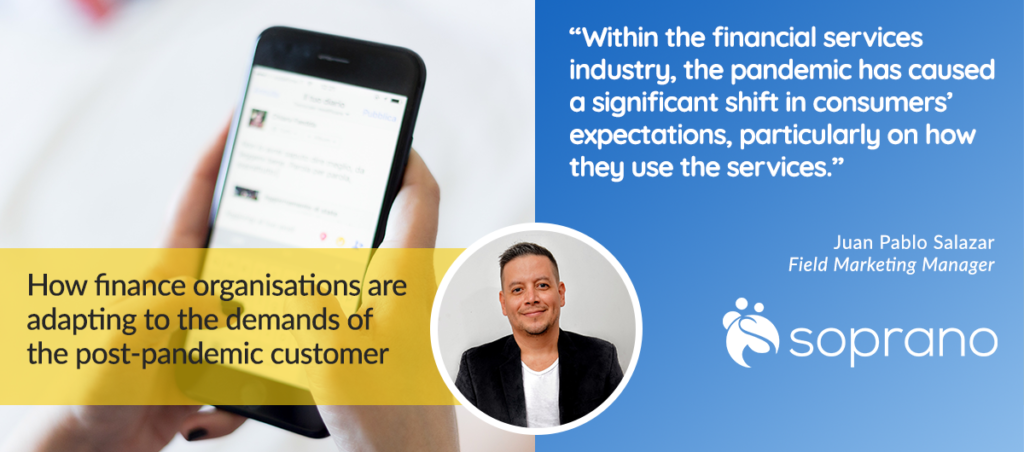
Within the financial services industry, the pandemic has caused a significant shift in consumers’ expectations, particularly on how they use the services. As a result, finance organisations are asking themselves how to create value for their customers. Find the answer in this article.
We will look at how the expectations of the financial consumer have evolved as a result of the global COVID-19 pandemic, the growing concerns they have, and how the right communication platform can help overcome these challenges.
Changes in financial customers’ expectations
It wasn’t the pandemic that triggered the change in finance customers’ expectations. The financial services sector has been undergoing a digital revolution for several years; the pandemic simply forced finance organisations to speed up their initiatives.
This is because finance customers are increasingly engaging digitally. According to a study by the EY Future Consumer Index , 46% of people switched to consuming digital financial services, and 59% preferred using online banking over visiting in person.
This data clearly shows that not only are financial consumers moving more to digital engagement, but that these new digital behaviours are here to stay.
The concerns of the digital financial consumer
While these changes are being readily accepted and adopted, they do bring with them new concerns.
To begin with, information security becomes a bigger challenge. Although the adoption of digital channels has increased, it does not mean that people have increased their trust in them. The digital adoption in finance has been more forced and comes with some degree of mistrust. The protection of accounts and financial information in an increasingly connected world is one of the biggest fears of the new financial consumer.
On the other hand, consumer confidence and the way a consumer interacts with their financial institution is also a concern. During the pandemic, the limitation of in-person office visits has impacted consumer confidence because they are forced to use impersonal communication channels. In these types of interactions, their attention is not as engaged as what a face-to-face service would enable.
How financial institutions can create value for customers
Financial entities have understood that the new financial consumer demands services that are aligned with their expectations in terms of trust and relationship.
Because of this, organizations have begun to make use of the tools at their disposal to provide highly personalized, empathetic and reliable services.
The starting point for this is data intelligence and its use through artificial intelligence (AI), which enables them to understand what, how and when their financial consumer uses their services.
In this sense, organizations are focusing on offering highly personalized financial services, considerably improving relations with their consumers as well as detecting potential fraud by finding “unusual” behaviors that are common to a consumer.
Financial institutions today concentrate efforts on improving relationships across the spectrum with their clients, from the generation of trust to a much more empathetic and close relationship.
According to a study by The Financial Brand, 84% of financial entities that focus on improving the customer experience report an increase in revenue and 92% report greater customer loyalty.
The role of mobile communication in finance
Mobile communication plays a fundamental role in the strategies and tactics that financial institutions use to adapt to the demands of the new financial consumer.
The use of mobile phones shot up almost 200% as a result of the pandemic, which led to an increase in online banking, demonstrating the importance that a mobile phone plays within communication.
We have described the importance of a personalized customer experience for new financial consumers, but isn’t the mobile phone the most personal device around?
It is for this reason and with these devices that financial entities should focus efforts to improve their relationship with their clients, to make them feel closer and increase trust by delivering the precise information they expect to receive in a timely manner and through the channels they want to use.
Delivering an offer additional credit, timely notification of a transaction, or establishing instant two-way communication channels with your clients, all of these allow your organisation to adapt to this new digital engagement.
How finance can create value by using the right technology
At Soprano, we believe that financial institutions can improve their relationships with their clients by adopting these more engaging technologies.
To do this right, organizations need players with extensive experience in the sector, who not only offer communication platform, but also a widely tested solution designed for the challenges required.
Soprano Connect, a communication solution offering financial messaging services, is a robust platform that each department of your organisation can use, that complies with existing data protection regulations and that is easily integrated into your IT systems.
Soprano Connect has implemented multiple security measures, certified under the ISO 27001 standard. In addition, the implementation of data encryption at rest and in motion together with its philosophy of “Security by Design” has allowed our platform to be chosen by large financial institutions around the world.
Start now to obtain all the benefits that mobile communication can provide to your financial institution. Fill out the form and one of our solutions experts will contact you.
